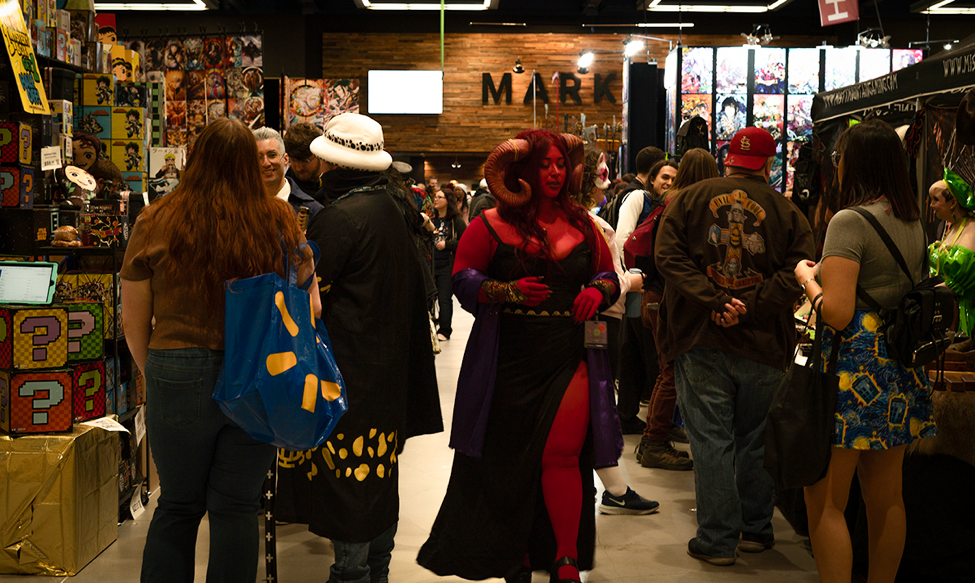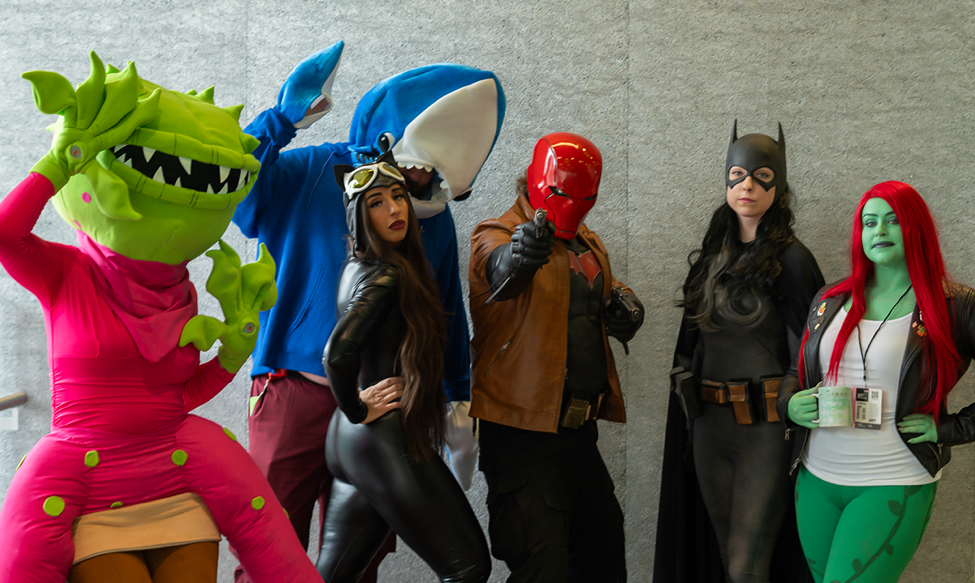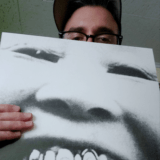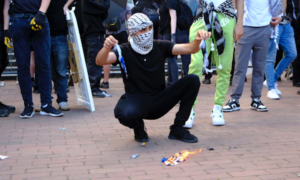Mutants, monsters, and aliens mingled with ninjas, robots, and royalty. Heroes and villains set aside their differences to come together for the Emerald City Comic Con (ECCC). Spanning Feb. 29 – Mar. 3, an estimated 85,000 attendees descended upon the Washington State Convention Center to show off their cosplay, meet their favorite celebrities and artists, attend industry panels, score a plethora of collectibles, and participate in workshops, live gaming events, and fan meet-ups. Whether Trekkies, gamers, otakus, or Dungeon Masters; there was something for all variety of nerds.
For myself and photographer Ethan Fields, the event left us equally ecstatic and exhausted. We were both first-timers with much to learn. The sheer size of the event and the density of the crowds made navigating the space seem like a perilous journey. But a palpable sense of joy kept our spirits from despair. There was no shortage of sights to see and experiences to enjoy across all corners of the convention.

The Convention Landscape
Occupying two buildings and eight combined levels, this year’s ECCC was a massive event. The Summit building housed much of the action. The show floor and merchandise covered the lowest level. The second floor featured the Writers Block, exhibitors, and Artist Alley. Live-action role-playing (LARPing) and tabletop gaming were found on the third. The fourth floor was cosplay central, with panel rooms, Pride Lounge, Dreamland Maid Café, and a free arcade. The top floor featured the main stage and family HQ. Across the way in the Arch building were all the celebrity events: cast panels, photo ops, and autograph signings.
Each day was jam-packed with diverse events catering to a diverse audience. If you wanted to get active, there were events like live-action role-playing games, lightsaber choreography for youth and adults, or samurai sword sparring. Dungeons & Dragons tutorials for beginners and live games for veterans happened all weekend, along with Magic: the Gathering and Pokémon Build & Battle. For those interested in cosplay, there were workshops on everything from hand stitching, leather working, and crafting foam weapons and armor, along with cosplay meet-ups and competitions. You could flex your knowledge at Nerd Trivia. Let loose at K-Pop Karaoke. Or work up the nerve to flirt at the Single Geek Fan 21+ Meetup. For those looking to start a career in the industry, a number of panels and workshops provided opportunities to get advice and learn vital skills from professionals.

One of the biggest highlights was Artist Alley. Rows and rows of bright colors and vivid imagery were a constant source of eye candy at every turn. A co-mingling of comic book artists and visual artists ranging from established industry veterans to newbies who sell on Etsy, side by side displaying their work and selling their wares. Looking around, one could spot many of their favorite characters from the various worlds of nerd culture. Oftentimes, these were reinterpretations of familiar characters in different art styles or in provocative depictions. It was exciting to see so many diverse takes on many of the same characters.
Walking through Artist Alley, I was pleasantly surprised to see so much queerness on display. Queer art and comics by LGBTQ+ artists were abundant. You didn’t have to look hard to spot your favorite heroes in revealing costumes and cheeky poses, often in the lurid embrace of their sworn nemesis. Or a portrayal of a sidekick as a partner in a more intimate sense. This is a family event, so the images were more playful than explicit. For attendees who inhabit mostly heteronormative spaces, seeing this side of comic culture might come as a shock. While these images may offend more conservative crowds and comic purists, they are refreshing and appeal to a younger, diversifying audience. They speak directly to one of the fastest-growing demographics in the comic industry. One that has existed under the surface throughout the history of the medium and is finally fully out in the open.

Some History
The convention has grown considerably since 2003, when the inaugural, single-day event drew roughly 2,500 to Qwest Field Events Center. While the turnout was modest, this was the perfect time to establish the ECCC. The turn of the century saw a major shift in popular culture. Propelled by major box office successes, the widespread success of video games, increased anime exposure, and the rise of the internet; nerd culture would soon conquer the mainstream.
The success of franchises like “X-Men” and “Spiderman” — in 2000 and 2002, respectively — led to the Marvel Cinematic Universe. “Star Wars” returned in 2001 with its Prequel Trilogy, reintroducing the franchise to a new generation of fans. Meanwhile, the “Lord of the Rings” film trilogy and the “Harry Potter” franchise — both launched in 200—set the stage for “Twilight,” “The Hunger Games,” and “Game of Thrones.”

After decades of failing to find a foothold on American television, anime finally escaped the early AM broadcasts thanks to Cartoon Network’s afternoon action-animation block Toonami finding success with “Sailor Moon” and “Dragon Ball Z” in 1998. The network added more anime as part of its late-night adult animation block with Adult Swim in 2001. And “Pokémon” ignited a craze amongst youngsters when the game series and anime reached America in 1998.
The sixth generation of console gaming saw more competition for industry leader Nintendo. The Microsoft Xbox, released in 2001, outsold Nintendo’s Gamecube. And the Sony Playstation 2 is the best-selling console of all time. This generation of consoles was the first to offer online play, starting with the Sega Dreamcast, followed by the PS2 and Xbox. Gamers around the world could now team up or face off in their favorite video games. People were connecting over their hobbies, passions, and fandom the world over. Much of what had been considered “nerd culture” was rapidly becoming a popular culture.
It can’t be overstated how much the internet changed the cultural landscape since its commercialization in 1995. Being tech-savvy branded you a nerd in those days, so it was the “nerds” who were early adopters of the technology. Fan sites and chat rooms proliferated, creating a vast global network of nerd culture. This created greater access to foreign IPs that were previously hard to come by.

With all of these industries growing in popularity over the next two decades, it’s no wonder that the Emerald City Comic Con has grown into the massive event it is today. Generations of fans have been raised entirely in an era where what was once considered nerdy is now the norm. The culture continues to grow. Just recently, an article in The Guardian declared that with the success of the recent TV adaptation of the “Fallout” franchise, video game adaptations are officially mainstream. Following the successes of “The Super Mario Bros. Movie” and the TV adaptation of the game series “The Last of Us,” it wouldn’t be a surprise to see video game adaptations usurp the fading Marvel Cinematic Universe as the next corner of nerd culture to be strip-mined for ratings and box office gold.
In spite of the mainstream, there still exists a robust world of independent and underground nerd culture — especially in the world of comics. In 1954, the Comics Code Authority adapted the “Comics Code” — similar to Hollywood’s Hays Code — as an alternative to government regulation. It wouldn’t take long for artists to find ways to work outside of it. The Underground Comix revolution of the ’60s and ’70s was a response to censorship that saw satirical and irreverent series like Robert Crumb’s “Zap Comix” take off.
Queer coding had been going on in mainstream comics since the beginning. The rise of the Underground Comix movement gave marginalized LGBTQ+ artists of the day an avenue to combat the negative stereotypes the Comics Code implied. Comics like “Come Out Comix” by Mary Wings in 1973 and “Gay Heart Throbs” by Gary Fuller in 1976 spoke explicitly to queer audiences. In spite of the Code, artistic expression prevailed, and the LGBTQ+ community thrived in the underground.
Independent comics grew in popularity over the decades, and major studios slowly abandoned The Code. By 2011, the last major comics studios — DC and Archie Comics — ceased code approval, rendering it defunct. This further legitimized underground and queer comics. No longer underground or in the closet, the field of queer comics is one of the fastest-growing markets in the industry. This was evident at Emerald City Comic Con.

On top of all the LGBTQ+ artists in Artist Alley, there were a number of events and panels focused on representation in the world of comics and media. Literary panels like “Queer Is the New Normal in Fantasy” and “Superqueer: A Discussion on LGBTQ+ Representation in Superhero Media and Power Structures” touched on the growing number of queer characters and their positive social impact. “Don’t be a Drag, Just Be a Queen” conflated the worlds of cosplay and drag, providing tips on how to blend the two successfully. And events like Gayme Time and Drag Queen Bingo provided playful, inclusive fun.
Admittedly, as a cisgendered straight male, this side of the culture is somewhat outside my purview. Thankfully, I had Ethan Fields in tow. Fields — who is gay, goth, and a lover of all things nerdy and queer — was the ideal guide on this journey. I’ve always loved video games, anime, and genres like sci-fi, horror, and fantasy; comics and manga are more recent loves. Fields has been a lifelong lover of comics. I was treated to history lessons on both mainstream comics and the rise of queer comics in the industry. They had this to say about the industry finally opening the door and embracing queerness:
“As an adult queer comic lover who grew up right before the kind of inclusivity era in comics kicked off, I absolutely love it. Having out-and-proud heroes is tremendously exciting, especially for kids today who get to witness these new changes as just part of comic culture. We still have a long way to go, but the fact that we’re getting Pride-themed books, heroes with disabilities, etc. Not to mention queer characters who aren’t completely pure or evil — and make mistakes and are messy — just add depth to them and just show that we’re headed in the right direction. I can’t wait to see what the future holds for our queer comic characters and even potentially be a part of that world someday.”
All Hands In
The Emerald City Comic Con provided a welcoming and inclusive environment that was suitable for all ages and all levels of experience. As it grows and reaches a wider audience, it’s encouraging to see that audience grow more diverse. Long gone are the days when the word “nerd” typified a crowd of mostly white males lacking style and social skills. That was never the reality, merely a stereotype. The crowds at ECCC were clear evidence this culture spans the demographic spectrum.

It’s encouraging to see the wider representation of diverse perspectives across comic conventions and nerd culture. There will always be a vocal contingent of miserly message board users grousing about the “colored hair mob” turning their culture “woke.” Complain all they want, no one group can lay claim to a culture this vast. It will continue to grow and reach wider audiences, further diversifying. This fosters even more connections between passionate fans across the culture and across the globe. This culture is a community. A community that celebrates its differences as strengths. Growing stronger together.
The Emerald City Comic Con returns March 6-9, 2025. Start working on your cosplay.
Author

Joel is an art damaged music nerd occasionally hugging trees and decrying the brutal nature of capitalism. He studied cultural anthropology and art history as an undergrad and is pursuing his AAS in graphic design at the Seattle Central Creative Academy. When not working on art, music, or writing, he’s usually hiking, biking, or lounging in his hammock reading manga.













Be First to Comment